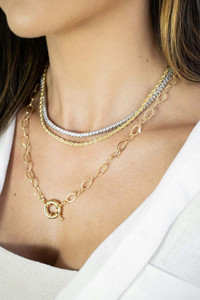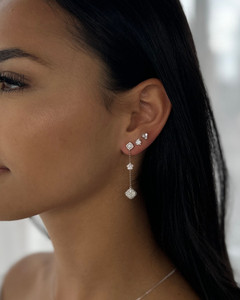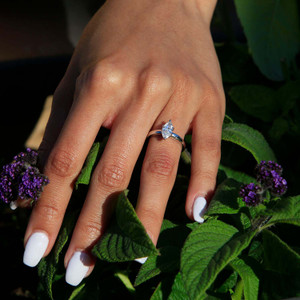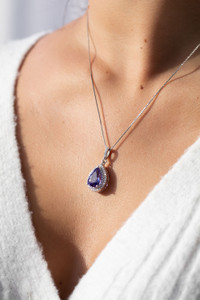Unveiling the Truth: 12 Ways to Authenticate Your Diamond

When shopping for diamond rings in Canada or browsing an online diamond ring store, it's crucial to know how to distinguish genuine diamonds from imitations. Whether you're looking at diamonds rings for a special occasion or considering diamond bands for women, these 12 methods will help you verify the authenticity of your precious stone.
The Allure of Real Diamonds
Before diving into authentication methods, let's explore what makes real diamonds so captivating. Genuine diamonds possess unique optical properties that set them apart from other gemstones and imitations.
Brilliance and Fire: The hallmark of a real diamond is its exceptional ability to reflect and refract light. This creates a dazzling display of white light (brilliance) and colorful flashes (fire) that catch the eye.
Precision Cuts: Authentic diamonds, especially those found in high-quality diamond rings for women, feature sharp, precise facets that contribute to their overall sparkle and light performance.
Natural Imperfections: Contrary to popular belief, most natural diamonds contain tiny internal flaws called inclusions. These imperfections, formed during the diamond's creation deep within the Earth, can actually help authenticate a stone.
Distinguishing Real from Fake
As the demand for diamond rings in Canada and worldwide continues to grow, so does the market for diamond simulants. These fake diamonds may resemble the real thing at first glance but lack the chemical composition and physical properties of genuine diamonds.
Common diamond simulants include:
- Cubic Zirconia
- Moissanite
- White Sapphire
- Glass or Crystal
While some of these alternatives can be beautiful in their own right, it's important to know what you're buying, especially when shopping at an online diamond ring store.

12 Diamond Authentication Methods
Now, let's explore 12 ways to test if your diamond is real. While professional assessment is always recommended for absolute certainty, these methods can provide valuable insights.
The Sparkle Test
Real diamonds have a unique way of interacting with light due to their high refractive index. When examining diamond rings for women, pay attention to the stone's sparkle:
- Genuine diamonds emit bright white light (brilliance) with some colorful flashes (fire).
- Fake stones often appear duller or may show excessive rainbow-like reflections.
The Loupe Inspection
Jewelers use a magnifying tool called a loupe to examine diamonds closely. When shopping for diamond bands for women, ask to see the stone under magnification:
- Look for sharp, well-defined facet edges in real diamonds.
- Check for tiny natural inclusions, which are common in genuine stones.
- Imitation diamonds often have rounded edges and may appear too perfect.
The Water Test
This simple test relies on the high density of diamonds:
- Fill a glass with water.
- Carefully drop the loose stone into the water.
- A real diamond will sink due to its high density.
- Many fake diamonds will float or remain suspended in the water.
The Newspaper Test
This test takes advantage of a diamond's high refractive index:
- Place the stone face-down on a piece of newspaper with small print.
- Look through the diamond at the text.
- If you can read the words, even if they're blurry, the stone is likely fake.
- Real diamonds refract light so strongly that you shouldn't be able to see through them clearly.
The UV Light Test
Some, but not all, diamonds exhibit fluorescence under ultraviolet light:
- Expose the stone to a UV light source in a dark room.
- Many real diamonds will emit a blue glow.
- Some genuine diamonds may not fluoresce, so this test isn't definitive.
The Conductivity Test
Professional jewelers often use special tools to test a diamond's thermal and electrical conductivity:
- Diamond testers measure how quickly a stone conducts heat or electricity.
- Real diamonds have distinct conductivity properties that set them apart from most imitations.
The Setting Examination
When evaluating diamond rings in Canada or elsewhere, pay attention to the setting:
- High-quality diamonds are typically set in precious metals like gold or platinum.
- Look for hallmarks indicating the metal's purity (e.g., 14K, 18K, PT).
- Be cautious of settings that seem too inexpensive for a genuine diamond.
The Weight Test
Diamonds have a specific gravity that differs from many simulants:
- Compare the weight of your stone to a known genuine diamond of similar size.
- Cubic zirconia, a common simulant, is about 1.7 times heavier than a diamond of the same size.

The Refractometer Test
Professional jewelers use a refractometer to measure a stone's refractive index:
- Diamonds have a unique refractive index of 2.417.
- Most simulants have lower refractive indices, helping to distinguish them from real diamonds.
The Certificate Verification
When shopping at an online diamond ring store or in person, always ask for a diamond certificate:
- Reputable grading laboratories like GIA provide detailed reports on a diamond's characteristics.
- These certificates offer the most authoritative confirmation of a diamond's authenticity and quality.
The Professional Appraisal
For the most definitive assessment, especially for valuable diamond rings for women, seek a professional appraisal:
- Experienced gemologists have access to advanced tools and expertise.
- They can provide a comprehensive evaluation of your diamond's authenticity and value.

Making an Informed Decision
- Research reputable sellers: Look for established jewelers with positive reviews and clear return policies.
- Ask questions: Don't hesitate to inquire about a diamond's origin, certification, and any treatments it may have undergone.
- Compare prices: If a deal seems too good to be true, it probably is. Be wary of diamonds priced significantly below market value.
- Consider lab-grown options: Some online diamond ring stores offer lab-created diamonds, which are chemically identical to mined diamonds but often more affordable.
- Prioritize cut quality: A well-cut diamond will exhibit better brilliance and fire, enhancing its overall beauty.
- Don't forget about the setting: When choosing diamond bands for women, consider how the setting complements the stone and suits the wearer's style.
- Get insurance: Once you've verified your diamond's authenticity, protect your investment with appropriate insurance coverage.
Conclusion
While these tests can provide valuable insights, remember that the most reliable way to authenticate a diamond is through professional assessment. Whether you're exploring diamond rings in Canada, browsing an online diamond ring store, or considering diamond bands for women, take the time to verify your purchase.
By combining these authentication methods with careful research and professional guidance, you can shop for diamonds rings with confidence. Remember, a genuine diamond isn't just a beautiful gem – it's a testament to nature's artistry and a symbol of enduring value.





